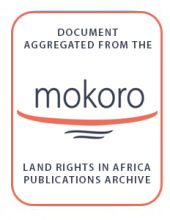Land Library Search
Through our robust search engine, you can search for any item of the over 73,000 highly curated resources in the Land Library.
If you would like to find an overview of what is possible, feel free to peruse the Search Guide.
/ library resources
Showing items 1 through 9 of 42.A letter from the Prime Minister dated 16 January 2008, and cited in the Constitution Court Ruling No 15/2552, in defense of the Community Forest Bill shows how “community rights” are often seen as contingent upon the responsibility of the communities to take care of the forest.
Conflict over land, combined with the systematic violation of land rights, is one of the most prominent human rights problems faced by Cambodians. The root of this problem can be traced back to the abolition of private ownership by the Khmer Rouge in 1975.
A presentation on the effects of the 3-S hydropower development on water access, available land resources and impacts on food production.
A discussion paper by Robyn Johnston, Michael Roberts, Thuon Try and Sanjiv de Silva on groundwater for irrigation in Cambodia, published by International Water Management Institute, Colombo, Sri Lanka, iDE Cambodia in June 2013.
The research employs case studies to grasp the processes and forms of ongoing land consolidation, factors affecting land consolidation, viewpoints on land consolidation and impacts of land consolidation on stakeholders and the society.
Examines the role of development cooperation in land reforms and the extent to which donor organisations have addressed concerns related to gender equality. Reviews the reforms in 15 countries in Africa, Latin America and Asia, with a focus on Ghana, Tanzania, Uganda, Zambia and Nicaragua.
Tanzania’s land reform from 1999 has been evaluated as among the most gender-sensitive of its kind in sub-Saharan Africa. However there is a gap between the legal framework and what is happening on the ground.
The Myanmar government introduced two new land laws in 2012 as part of an effort to liberalize land markets. This report analyzes the implementation of these laws using theory, field research, and a comparative regional analysis. It also offers recommended interventions.
Includes the impacts of failed large-scale investments: the case of Bioshape; Bioshape’s land acquisition process at the national, district and village level; the impacts of Bioshape’s investment in Kilwa; the biofuel boom and bust in Tanzania 2005-11; options for the affected villagers, policy i


